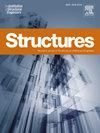基于车辆扫描方法的非梁桥频率识别:解析公式和实验验证
IF 4.3
2区 工程技术
Q1 ENGINEERING, CIVIL
引用次数: 0
摘要
本文提出了一种新的解析公式,演示了如何从过桥的仪表车辆记录的振动中识别任何桥梁的固有振动频率——无论其结构类型、几何形状或边界条件如何。该公式消除了传统的正弦模态振型假设,拓宽了车辆扫描方法用于桥梁频率识别的范围,而传统的正弦模态振型假设限制了车辆扫描方法在简支梁桥中的应用。该方法首先使用傅里叶级数展开桥梁振动,证明只有桥梁的固有频率对该展开有非零项贡献。这是普遍适用的,独立于桥梁类型和几何形状。利用Duhamel积分计算了车辆通过桥梁的响应,解析证明了桥梁的固有频率出现在车辆的振动谱中。为了验证这个公式,我们提出了两个应用。首先对一座80 m钢拱桥进行了数值模拟,通过特征值分析确定了其非正弦模态振型。虚拟车辆过桥仿真表明,在车辆振动的傅立叶振幅谱(FAS)中可以清晰地识别桥梁的固有频率。其次,在602 m斜拉桥上进行现场测试,使用配备低成本车顶加速度计的仪表车辆。成功地从车辆记录的振动中提取了桥梁的前三个模态频率,证明了所开发的公式在现实条件下的实际可行性。本文章由计算机程序翻译,如有差异,请以英文原文为准。
Frequency identification of non-beam bridges using vehicle scanning methods: Analytical formulation and experimental validation
This article presents a novel analytical formulation that demonstrates how the natural vibration frequencies of any bridge - regardless of its structural type, geometry, or boundary conditions - can be identified from the vibrations recorded by an instrumented vehicle crossing the bridge. This formulation broadens the scope of vehicle scanning methods for bridge frequency identification by removing the traditional assumption of sinusoidal mode shapes, which previously limited their application to simply supported beam bridges. The methodology begins by expanding bridge vibrations using a Fourier series, demonstrating that only the natural frequencies of the bridge contribute nonzero terms to this expansion. This is universally applicable, independent of bridge typology and geometry. Using Duhamel’s integral, the response of a vehicle traversing the bridge was computed to analytically prove that the bridge’s natural frequencies appear in the vehicle’s vibration spectrum. To validate the formulation, we present two applications. First, a numerical study models an 80 m steel arch bridge, confirming its non-sinusoidal mode shapes through eigenvalue analysis. A virtual vehicle crossing simulation reveals that the bridge’s natural frequencies are clearly identifiable in the Fourier amplitude spectrum (FAS) of the vehicle vibrations. Second, a field test is conducted on a 602 m cable-stayed bridge using an instrumented vehicle equipped with low-cost roof-mounted accelerometers. The first three modal frequencies of the bridge are successfully extracted from the vehicle’s recorded vibrations, demonstrating the practical feasibility of the developed formulation in real-world conditions.
求助全文
通过发布文献求助,成功后即可免费获取论文全文。
去求助
来源期刊

Structures
Engineering-Architecture
CiteScore
5.70
自引率
17.10%
发文量
1187
期刊介绍:
Structures aims to publish internationally-leading research across the full breadth of structural engineering. Papers for Structures are particularly welcome in which high-quality research will benefit from wide readership of academics and practitioners such that not only high citation rates but also tangible industrial-related pathways to impact are achieved.
 求助内容:
求助内容: 应助结果提醒方式:
应助结果提醒方式:


